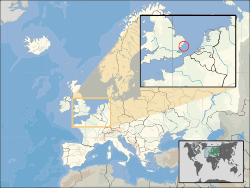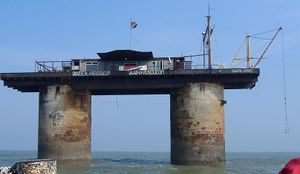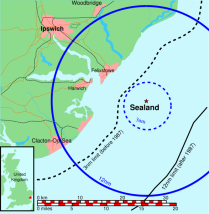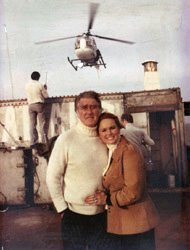Principality of Sealand
Principality of Sealand | |
|---|---|
| Motto: "E Mare Libertas" (Latin) "From the Sea, Freedom" (English) | |
 Location of Sealand | |
| Location | North Sea, 13 Kilometers from the Coast of Suffolk |
| Capital | HM Fort Roughs |
| Official languages | English |
| Demonym(s) |
|
| Government | Constitutional monarchy |
• Prince | Michael I |
| Establishment | |
• Foundation | 2 September 1967 |
| Population | |
• Estimate | 23 (2011) |
• Density | 5/km2 (12.9/sq mi) |
| Currency | Sealand Dollar |
| Date format | dd-mm-yyyy |
| IMSO 1 code | SEA |
The Principality of Sealand, commonly known as Sealand, is a micronation that claims as its territory the artificial island of Roughs Tower, a former Maunsell Sea Fort located in the North Sea 10 km (six miles) off the coast of Suffolk, England, as well as territorial waters in a twelve-nautical-mile radius. Sealand is occupied by family members and associates of Paddy Roy Bates, who styled himself as H.R.H. Prince Roy of Sealand. Prince Roy died in 2012, and the principality is today run by his son, Prince Michael I. The population of the facility rarely exceeds five, and its inhabitable area is 550m².
Although Sealand's claims to sovereignty and legitimacy are not recognized by any UN-recognized country, it is probably the world's best-known micronation, and is sometimes cited in debates as an interesting case study of how various principles of international law can be applied to a territorial dispute. There are numerous corporate companies that currently claim to the legitimate representation of Sealand, the main one being run by a group of German businessmen, for claim to the Government-in-exile of the Principality, and use this title to issue fraudulent citizenship papers, lotteries, banks and even Online Gambling. The Principality has recently begun to operate its own Forum and even sell parts of Sealand, although these do stay under the Sovereignty of Sealand.
History
In 1942, during World War II, HM Fort Roughs was constructed by the UK as one of the Maunsell Sea Forts. It comprised a floating pontoon base with a superstructure of two hollow towers joined by a deck upon which other structures could be added. The fort was towed to a position above Rough Sands sandbar where its base was intentionally flooded so that it sank to a resting place on the sandbar. The location chosen was in international waters, outside the then three-mile territorial water claim of the United Kingdom.
The facility (termed Roughs Tower) was occupied by 150–300 Royal Navy personnel throughout World War II; post-war it was not until 1956 that the last full-time personnel were taken off HM Fort Roughs and marking of its position as a shipping hazard was left to Trinity House. On September 2, 1967, the fort was occupied by Major Paddy Roy Bates, a British subject and pirate radio broadcaster, who ejected a competing group of pirate broadcasters and claimed sovereignty on the basis of his interpretation of international law (see Legal status).

In 1968, Roy's son Michael Bates was summoned to court as a result of an incident during which shots were fired at a British navy vessel or by Trinity House in the vicinity of Sealand. According to some reports the vessel's occupants were intending to evict the Bates family from the fortress, while others state that they were simply attempting to repair a nearby navigation buoy. In delivering its decision on November 25, 1968, the court, in Chelmsford, Essex, stated that because the incident occurred outside British territorial waters, the court possessed no jurisdiction. Bates cited this case as evidence of de facto sovereignty.
In 1978, while Bates was away, the Prime Minister of Sealand, Alexander G. Achenbach, and several German and Dutch citizens, staged a forcible takeover of Roughs Tower, holding Bates' son Michael captive, before releasing him several days later in the Netherlands.
Bates thereupon enlisted armed assistance and, in a helicopter assault, retook the fortress. He then held the invaders captive, claiming them as prisoners of war. Most participants in the invasion were repatriated at the cessation of the "war", but Gernot Pütz, a German lawyer who held a Sealand passport, was charged with treason against Sealand and was held unless he paid DM75,000 (more than £18,000). The governments of the Netherlands and Germany petitioned the British government for his release, but the United Kingdom disavowed all responsibility, citing the 1968 court decision. Germany then sent a diplomat from its London embassy to Roughs Tower to negotiate for Pütz's release, and after several weeks Roy Bates relented, subsequently claiming that the diplomat's visit constituted de facto recognition of Sealand by Germany.
Following his repatriation, Achenbach established an exile government in Germany, in opposition to Roy Bates, assuming the name "Chairman of the Privy Council". Upon Achenbach's resignation for health reasons in August 1989, the rebel government's "Minister for Economic Co-operation", Johannes Seiger, assumed control, with the position of "Prime Minister and Chairman of the Privy Council". Seiger continues to claim that he is Sealand's legitimate ruling authority.
Sealand claims the waters surrounding Roughs Tower to the extent of twelve nautical miles,[1] and it has claimed to have physically defended this claim on at least one occasion: in an incident in 1990, the Royal Maritime Auxiliary vessel Golden Eye was fired upon from Sealand.
For a period, Sealand passports were manufactured and sold widely (mostly to Eastern Europeans) by a Spain/Spanish-based group. These passports, which were not authorised by the Bates family, were linked to several high-profile crimes, including the murder of Gianni Versace. Due to the massive quantity of illegal passports in circulation (estimated at 150,000), in 1997 the Bates family revoked all Sealand passports, including those that they themselves had issued in the previous thirty years.
In 1987 the UK expanded its territorial waters by 9 nautical miles. This encompassed the Rough Sands area. In 1990-1991 the UK submitted evidence in a U.S. Administrative Court Case, the ruling for which included a statement to the effect that no independent "Principality of Sealand" had ever existed. This case was not challenged by the Bates family, who assert that U.S. courts have no jurisdiction in determining the legitimacy of other states.
In June 2006, Sealand suffered from a fire due to an electrical fault. The blaze was put out by firefighters, and it was repaired by November. In 2012, Prince Roy died, and was succeeded as Prince of Sealand by his son, Michael.
Legal status

Sealand's claim that it is an independent state is founded on the following two propositions:
- When Paddy Roy Bates and his associates occupied Roughs Tower in 1967 it was located in international waters, outside the jurisdiction of the United Kingdom and all other sovereign states. Sealand claims de jure legitimacy on this basis.
- The interactions of the UK government with Sealand constitute de facto recognition. Sealand claims de facto legitimacy on this basis.
In international law, the two most common schools of thought for the creation of statehood are the constitutive and declaratory theories of state creation. The constitutive theory was the standard nineteenth century model of statehood, and the declaratory theory was developed in the twentieth century to address shortcomings of the constitutive theory. In the constitutive theory, a state exists exclusively via recognition by other states. The theory splits on whether this recognition requires "diplomatic recognition" or merely "recognition of existence". It is clear that no other state grants Sealand diplomatic recognition, but it has been argued by Bates that negotiations carried out by Germany constituted "recognition of existence". In the declaratory theory of statehood, an entity becomes a state as soon as it meets the minimal criteria for statehood. Recognition by other states is purely "declaratory".
One set of criteria for statehood under international law is defined by the Montevideo Convention. This asserts that a defined territory, permanent population, government and the capacity to enter into relationships with other sovereign states are the only foundation requirements for a sovereign state. None of these requirements necessarily has to conform to a certain size or standard, but their general characteristics should be taken into account.
A similar set of criteria for statehood is found in the European Community Opinions of the Badinter Arbitration Committee. The committee found that a state was defined by having a territory, a population, and a political authority. The committee also found that the existence and disappearance of states was a question of fact, while the recognition by other states was purely declaratory.
Since the 1968 UK court decision, the United Kingdom has extended its territorial sea to twelve nautical miles (22 km), which it had the legal right to do under international law since 1958 (although the necessary Act of Parliament was not passed until 1987). These and subsequent laws have dealt with the construction and legal position of artificial islands. However, as Roughs Tower is actually a sunken ship, some have claimed it is not covered by these rulings. Sealand declared that it, too, was extending its claim of territorial waters to twelve nautical miles at a similar time to the UK.
According to the 1982 United Nations Convention on the Law of the Sea, there is no transitional law and no possibility to consent to the existence of a construction which was previously approved or built by a neighbouring state. This means that artificial islands may no longer be constructed and then claimed as sovereign states, or as state territories, for the purposes of extension of an exclusive economic zone or of territorial waters. However, since Roughs Tower is not an artificial island but a sunken ship, it would be necessary for His Majesty's Crown Estate (which owns the land itself under the tower) to act as the complainant landlord in order to get the wreck removed from its property. If Sealand is a sunken ship rather than an artificial island then no claim to statehood can be made, as a ship cannot constitute the "permanent" territory required for statehood to be established.
The only prospect for successful assertion of sovereignty would be to show that there was de facto sovereignty prior to 1968.
Although the UK has publicly asserted its authority over Roughs Tower [2], it appears to be government policy to refrain from comment or action except when forced. British Government documents, now available to the public under the 30-year expiry of confidentiality, show that the UK drafted plans to take the tower by force, but such plans were not implemented by the then Prime Minister due to the potential for loss of life, and the creation of a legal and public relations disaster.
In 1978 a German court ruled that Sealand was not a valid nation: "A man-made artificial platform, such as the so-called Duchy of Sealand, cannot be called either 'a part of the earth's surface' or 'land territory' and only structures which make use of a specific piece of the earth's surface can be recognised as State territory within the meaning of international law." (In re Duchy of Sealand (1978) 80 ILR 683, 685 (Administrative Court of Cologne))
In 1990 a US Administrative Court also ruled that Sealand was not a valid sovereign nation, following evidence from James Murphy of the Department of Trade and Industry. On appeal in 1991 the decision that the state called Sealand does not exist, and has not ever existed was upheld by a US Federal Court.
The Times on December 6, 2005, claimed that the British government and courts finally admitted that Sealand "is outside British national territory [...] and not part of the United Kingdom", however The Times did not elaborate and there has been no confirmation by other sources. [3] The Assembly of Sealand is a micronational institution that allows users to vote about proposals of Sealand.
The Bates family

Irrespective of its legal status, Sealand is managed by the Bates family as though it were a recognised sovereign entity, and they are its hereditary Royal family.
Roy and Joan Bates have been referred to internally since the foundation of Sealand as "Their Royal Highnesses Prince Roy and Princess Joan of Sealand". Roy Bates is styled "Sovereign", and Joan Bates is sometimes described as being "in joint rule" with him. Their son is known as "His Royal Highness Prince Michael". Michael Bates has been referred to as the "Prince Regent" since 1999. In this role he apparently serves as Sealand's acting "Head of State" and also its "Head of Government". At a micronations conference hosted by the University of Sunderland on 25 November, 2004, Sealand was represented by Michael Bates' son James, who was referred to as "Prince Royal James".
Sealand's royals are all believed to retain UK citizenship, and the family has not been in permanent residence on the Roughs Tower facility since 1999. The facility is now occupied by one or more caretakers representing Michael Bates, who himself lived in Leigh on Sea, England. As Sealand is not a recognised country, the Bates family officially travel internationally as British citizens.
Sealand operations
Sealand possesses a simple constitution, instituted in 1995, which consists of a preamble and seven articles. The preamble asserts Sealand's independence, while the articles variously deal with Sealand's status as a constitutional monarchy, the empowerment of government bureaus, the role of an appointed, advisory Senate, the functions of an appointed, advisory legal tribunal, a proscription against the bearing of arms except by members of a designated "Sealand Guard", the exclusive right of the sovereign to formulate foreign policy and alter the constitution, and the hereditary patrilinear succession of the monarchy.
Current Sealand government bureaus are: the Bureau of International relations|External Affairs, the Bureau of Internal Affairs, and the Bureau of Mail|Posts Telecommunication|Telecomms and Technology. Most of the organs of Sealand's government are apparently either inactive or operate outside of Sealand's territory itself. A Sealand State Corporation was chartered by Roy Bates and charged with the "development of the state" shortly after Sealand's foundation, but its current status and range of activities, if any, are unknown.
In 2000, worldwide publicity was created about Sealand due to the establishment of a new entity called HavenCo, a data haven, which effectively took control of Roughs Tower itself. According to the Sealand official website, no other visitors or activities would be permitted [4]. The original claim to the right to occupy Roughs Tower was maintained by Michael Bates, whose father Roy has removed himself to a great extent from further daily involvement. However Ryan Lackey, HavenCo's founder, later quit and claimed that Bates had lied to him by keeping the 1990-1991 court case from him and that as a result he had lost the money he had invested in the venture. He stated that his only legal recourse was to sue Roy Bates in a British court of law but to date no action has been taken.
Sealand's legal system is claimed to follow British common law, and statutes take the form of Decrees enacted by the Sovereign.
In 2003, Sealand appointed its first official athlete: Darren Blackburn of Oakville, Ontario, Canada. Blackburn has represented the Principality—apparently in a tongue-in-cheek manner—at a number of local sporting events, including marathons and off-trail races.
Postal service and stamps
Sealand first issued postage stamps in 1969, when a helicopter service was instituted to carry mail between Roughs Tower and Brussels, Belgium. A significant volume of mail carrying Sealand stamps and postmarks was accepted without surcharge and passed by Belgian postal authorities into the international postal system at this time[citation needed].
Although few stamp issues have been made since early 1970s, Sealand postage stamps and postal cancellations continue to be used on most if not all mail from the principality, although the actual volume of such mail is limited.
The official policy of the United Kingdom's Royal Mail is to stamp envelopes not bearing UK stamps with a 'revenue protection' cancellation, meaning that postal carriage charges may be claimed from the recipient – although recent examples exist of mail bearing Sealand stamps and cancellations, to the exclusion of all others, being transmitted through the international postal system.
Sealand is not a member of the Universal Postal Union, which regulates the sending of mail between countries, and its address is in what it claims is a foreign country. In a similar manner, mail for the Turkish Republic of Northern Cyprus must be addressed to 'Mersin 10, Turkey'. The address publicised by Sealand as its postal address is: 'Sealand 1001; Sealand Post Bag, IP11 9SZ, UK'. The Royal Mail Postal postcode is the one for Felixstowe near Ipswich, England, and the Royal Mail website gives the following standardised address: 'Sealand Fort, PO Box 3, FELIXSTOWE, IP11 9SZ, UK'.
According to the Cinderella Stamp Club (UK), Sealand's stamps are classified as "locals"; such stamps are valid for the carriage of mail between a location that lacks a regular postal service, and a location from which the onward transmission of such mail occurs.
Coins
Sealand has declared its currency to be the "Sealand Dollar", which it deems to be at parity with the U.S. dollar. Several dozen different coins have been minted since 1972 in various units of this currency. Given Sealand's limited population, physical inaccessibility and lack of a real economy it is unlikely that these coins were ever intended for use as circulating currency. Most were produced in precious metals, which have appealed to investors and coin collectors. In the early 1990s, Achenbach's German group also produced a coin, featuring a likeness of Prime Minister Seiger.
References
- Garfinkel, Simson. "Welcome to Sealand. Now Bugger Off". Wired Magazine. July 2000. Vol. 8.07.
- Gilmour, Kim. "Sealand: Wish You Were Here?" Internet Magazine. August 2002.
- "Has 'haven' for questionable sites sunk?". News.com. August 4, 2003.
- Lackey, Ryan. "Haven Company: What Really Happened" Address at Defcon 11 Las Vegas, August 3, 2003.
- Miller, Marjorie & Boudreaux, Richard. "A Nation for Friend and Faux". Los Angeles Times. June 7, 2000. pA-1
- Slapper, Gary. "How a law-less 'data haven' is using law to protect itself". The Times. August 8, 2000. p3
- "Stop signs on the web; The battle between freedom and regulation on the Internet". The Economist. Jan 13, 2001. p1
- Strauss, Erwin S. How to Start Your Own Country, 2nd ed. Port Townsend, WA: Breakout Productions, 1984. ISBN 1893626156
- Connelly, Charlie. Attention All Shipping: A Journey Round The Shipping Forecast, Abacus, 2005. ISBN 0349116032
External links
- Official website
- Archival Sealand website
- Website of Rebel Sealand Government
- Flags of the World (FOTW) Principality flag, standard, and coat of arms.
- National Anthem
- Alleged transcript of the 1968 UK court case
- Coins of Sealand - Complete catalogue of coins minted by Sealand.
- Meta Haven: Sealand Identity Project
- The Sea Forts - The history of Britain's World War II sea fortresses and their later use by 1960s pirate radio broadcasters.
- HMS Roughs - A skeptical legal analysis of Sealand.
- Sealand Movie - page for a forthcoming film about Sealand.
- Sealand & Havenco Photo Gallery - More Photos inside and out.
- Sealand, A Brief History - Danny Wallace's account of how Sealand inspired him to declare his flat independent from the United Kingdom
- Sealand statehood and nationality case – Administrative Court of Cologne, Germany, May 3, 1978
- Framed Nation Films - "E Mare Libertas" Sealand Documentary Film
- Darren Blackburn Website - Official website of Darren Blackburn - Sealand's first and only "official athlete"
- "Sealand: Wish You Were Here?" - Photographs and article by Kim Gilmour, Internet Magazine, August 2002
- Country's passports are for sale - Article from The Times about legality of Sealand (December 6, 2005)
- Opinions of the Badinter Arbitration Committee at the European Journal of International Law

